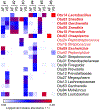Evidence that intra-amniotic infections are often the result of an ascending invasion - a molecular microbiological study
- PMID: 31693497
- PMCID: PMC7147941
- DOI: 10.1515/jpm-2019-0297
Evidence that intra-amniotic infections are often the result of an ascending invasion - a molecular microbiological study
Abstract
Background Microbial invasion of the amniotic cavity resulting in intra-amniotic infection is associated with obstetrical complications such as preterm labor with intact or ruptured membranes, cervical insufficiency, as well as clinical and histological chorioamnionitis. The most widely accepted pathway for intra-amniotic infection is the ascension of microorganisms from the lower genital tract. However, hematogenous dissemination of microorganisms from the oral cavity or intestine, retrograde seeding from the peritoneal cavity through the fallopian tubes, and introduction through invasive medical procedures have also been suggested as potential pathways for intra-amniotic infection. The primary reason that an ascending pathway is viewed as most common is that the microorganisms most often detected in the amniotic fluid are those that are typical inhabitants of the vagina. However, thus far, no studies have shown that microorganisms in the amniotic cavity are simultaneously present in the vagina of the woman from which they were isolated. The objective of the study was to determine the frequency with which microorganisms isolated from women with intra-amniotic infection are also present in the lower genital tract. Methods This was a cross-sectional study of women with intra-amniotic infection with intact membranes. Intra-amniotic infection was defined as a positive culture and elevated concentrations of interleukin-6 (IL-6) (>2.6 ng/mL) in amniotic fluid and/or acute histologic chorioamnionitis and funisitis. Microorganisms isolated from bacterial cultures of amniotic fluid were taxonomically identified through matrix-assisted laser desorption ionization-time of flight mass spectrometry (MALDI-TOF) and 16S ribosomal RNA (rRNA) gene sequencing. Vaginal swabs were obtained at the time of amniocentesis for the identification of microorganisms in the lower genital tract. The overall bacterial profiles of amniotic fluids and vaginal swabs were characterized through 16S rRNA gene sequencing. The bacterial profiles of vaginal swabs were interrogated for the presence of bacteria cultured from amniotic fluid and for the presence of prominent (>1% average relative abundance) operational taxonomic units (OTUs) within the overall 16S rRNA gene bacterial profiles of amniotic fluid. Results (1) A total of 75% (6/8) of women had bacteria cultured from their amniotic fluid that are typical residents of the vaginal ecosystem. (2) A total of 62.5% (5/8) of women with bacteria cultured from their amniotic fluid also had these bacteria present in their vagina. (3) The microorganisms cultured from amniotic fluid and also detected in the vagina were Ureaplasma urealyticum, Escherichia coli, and Streptococcus agalactiae. (4) 16S rRNA gene sequencing revealed that the amniotic fluid of women with intra-amniotic infection had bacterial profiles dominated by Sneathia, Ureaplasma, Prevotella, Lactobacillus, Escherichia, Gardnerella, Peptostreptococcus, Peptoniphilus, and Streptococcus, many of which had not been cultured from the amniotic fluid samples. (5) Seventy percent (7/10) of the prominent (>1% average relative abundance) OTUs found in amniotic fluid were also prominent in the vagina. Conclusion The majority of women with intra-amniotic infection had bacteria cultured from their amniotic fluid that were typical vaginal commensals, and these bacteria were detected within the vagina at the time of amniocentesis. Molecular microbiological interrogation of amniotic fluid from women with intra-amniotic infection revealed that the bacterial profiles of amniotic fluid were largely consistent with those of the vagina. These findings indicate that ascension from the lower genital tract is the primary pathway for intra-amniotic infection.
Keywords: 16S rRNA sequencing; Gardnerella; Sneathia; Ureaplasma; amniotic cavity; amniotic fluid; bacteria; chorioamnionitis; culture; funisitis; microbial invasion; microbiome; microbiota; pregnancy; preterm birth; vaginal flora.
Conflict of interest statement
Declaration of Interests Statement
We have no conflicts of interest to declare.
Figures



References
-
- Gravett MG, Eschenbach DA. Possible role of Ureaplasma urealyticum in preterm premature rupture of the fetal membranes. Pediatr Infect Dis. 1986;5(6 Suppl):S253–7. - PubMed
-
- Romero R, Mazor M. Infection and preterm labor. Clin Obstet Gynecol. 1988;31(3):553–84. - PubMed
-
- Watts DH, Krohn MA, Hillier SL, Eschenbach DA. The association of occult amniotic fluid infection with gestational age and neonatal outcome among women in preterm labor. Obstet Gynecol. 1992;79(3):351–7. - PubMed
-
- DiGiulio DB. Diversity of microbes in amniotic fluid. Semin Fetal Neonatal Med. 2012;17(1):2–11. - PubMed
MeSH terms
Substances
Grants and funding
LinkOut - more resources
Full Text Sources
